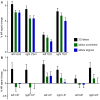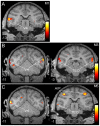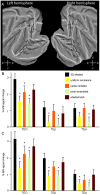The extraction of depth structure from shading and texture in the macaque brain
- PMID: 20011540
- PMCID: PMC2789404
- DOI: 10.1371/journal.pone.0008306
The extraction of depth structure from shading and texture in the macaque brain
Abstract
We used contrast-agent enhanced functional magnetic resonance imaging (fMRI) in the alert monkey to map the cortical regions involved in the extraction of 3D shape from the monocular static cues, texture and shading. As in the parallel human imaging study, we contrasted the 3D condition to several 2D control conditions. The extraction of 3D shape from texture (3D SfT) involves both ventral and parietal regions, in addition to early visual areas. Strongest activation was observed in CIP, with decreasing strength towards the anterior part of the intraparietal sulcus (IPS). In the ventral stream 3D SfT sensitivity was observed in a ventral portion of TEO. The extraction of 3D shape from shading (3D SfS) involved predominantly ventral regions, such as V4 and a dorsal potion of TEO. These results are similar to those obtained earlier in human subjects and indicate that the extraction of 3D shape from texture is performed in both ventral and dorsal regions for both species, as are the motion and disparity cues, whereas shading is mainly processed in the ventral stream.
Conflict of interest statement
Figures








Similar articles
-
The extraction of 3D shape from texture and shading in the human brain.Cereb Cortex. 2008 Oct;18(10):2416-38. doi: 10.1093/cercor/bhn002. Epub 2008 Feb 14. Cereb Cortex. 2008. PMID: 18281304 Free PMC article.
-
Parietal regions processing visual 3D shape extracted from disparity.Neuroimage. 2009 Jul 15;46(4):1114-26. doi: 10.1016/j.neuroimage.2009.03.023. Epub 2009 Mar 19. Neuroimage. 2009. PMID: 19303937
-
3D Shape Perception in Posterior Cortical Atrophy: A Visual Neuroscience Perspective.J Neurosci. 2015 Sep 16;35(37):12673-92. doi: 10.1523/JNEUROSCI.3651-14.2015. J Neurosci. 2015. PMID: 26377458 Free PMC article.
-
The extraction of 3D shape in the visual system of human and nonhuman primates.Annu Rev Neurosci. 2011;34:361-88. doi: 10.1146/annurev-neuro-061010-113819. Annu Rev Neurosci. 2011. PMID: 21456959 Review.
-
Neural mechanisms of three-dimensional vision.Neurosci Res. 2005 Mar;51(3):221-9. doi: 10.1016/j.neures.2004.11.006. Epub 2005 Jan 18. Neurosci Res. 2005. PMID: 15710485 Review.
Cited by
-
Neural selectivity and representation of gloss in the monkey inferior temporal cortex.J Neurosci. 2012 Aug 1;32(31):10780-93. doi: 10.1523/JNEUROSCI.1095-12.2012. J Neurosci. 2012. PMID: 22855825 Free PMC article.
-
Unique Neural Activity Patterns Among Lower Order Cortices and Shared Patterns Among Higher Order Cortices During Processing of Similar Shapes With Different Stimulus Types.Iperception. 2021 May 26;12(3):20416695211018222. doi: 10.1177/20416695211018222. eCollection 2021 May-Jun. Iperception. 2021. PMID: 34104383 Free PMC article.
-
Default mode of brain function in monkeys.J Neurosci. 2011 Sep 7;31(36):12954-62. doi: 10.1523/JNEUROSCI.2318-11.2011. J Neurosci. 2011. PMID: 21900574 Free PMC article. Review.
-
Abnormal effective connectivity in visual cortices underlies stereopsis defects in amblyopia.Neuroimage Clin. 2022;34:103005. doi: 10.1016/j.nicl.2022.103005. Epub 2022 Apr 8. Neuroimage Clin. 2022. PMID: 35421811 Free PMC article.
-
Binocular depth processing in the ventral visual pathway.Philos Trans R Soc Lond B Biol Sci. 2016 Jun 19;371(1697):20150259. doi: 10.1098/rstb.2015.0259. Philos Trans R Soc Lond B Biol Sci. 2016. PMID: 27269602 Free PMC article. Review.
References
-
- Todd JT. The visual perception of 3D shape. Trends Cogn Sci. 2004;8:115–121. - PubMed
-
- Zhang Y, Weiner VS, Slocum WM, Schiller PH. Depth from shading and disparity in humans and monkeys. Vis Neurosci. 2007;24:207–215. - PubMed
-
- Taira M, Tsutsui KI, Jiang M, Yara K, Sakata H. Parietal neurons represent surface orientation from the gradient of binocular disparity. J Neurophysiol. 2000;83:3140–3146. - PubMed
Publication types
MeSH terms
LinkOut - more resources
Full Text Sources
Research Materials

